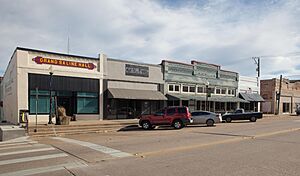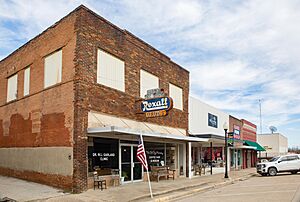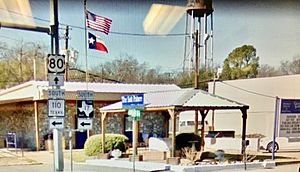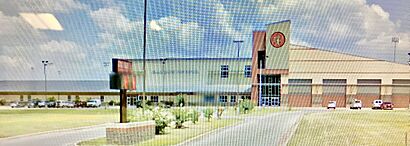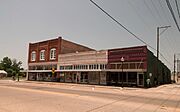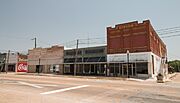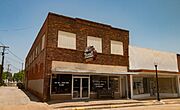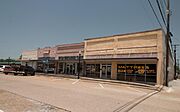Grand Saline, Texas facts for kids
Quick facts for kids
Grand Saline, Texas
|
|
|---|---|
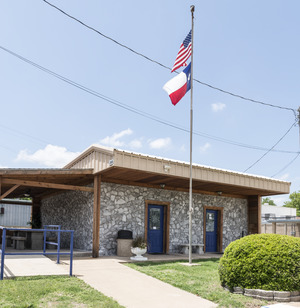
Grand Saline Salt Palace
|
|
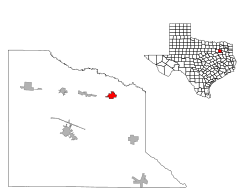
Location of Grand Saline, Texas
|
|
| Country | United States |
| State | Texas |
| County | Van Zandt |
| Area | |
| • Total | 2.12 sq mi (5.48 km2) |
| • Land | 2.10 sq mi (5.43 km2) |
| • Water | 0.02 sq mi (0.05 km2) |
| Elevation | 417 ft (127 m) |
| Population
(2020)
|
|
| • Total | 3,107 |
| • Density | 1,466/sq mi (567.0/km2) |
| Time zone | UTC-6 (Central (CST)) |
| • Summer (DST) | UTC-5 (CDT) |
| ZIP code |
75140
|
| Area code(s) | 903 Phone prefix: 962|913 |
| FIPS code | 48-30476 |
| GNIS feature ID | 2410633 |
Grand Saline is a city in Van Zandt County, Texas, United States. It is located in the eastern part of Texas, often called East Texas. In 2020, about 3,107 people lived there. This makes Grand Saline the third-largest city in Van Zandt County.
The city is about 75 miles (120 km) east of Dallas. It is also about 35 miles (56 km) northwest of Tyler. These are the two closest big cities. Grand Saline is part of the larger Tyler/Longview area. The town gets its name from the huge salt deposits nearby. Most of these salt deposits are owned by Morton Salt.
Contents
History of Grand Saline
Early Salt Discoveries
The first people to live in the Grand Saline area were the ancient Caddo and Cherokee Indian tribes. They found a large salt prairie south of the town. These Native American tribes used salt that had dried up from a salty stream. They traded this salt for other things they needed.
In the mid-1800s, these tribes moved southeast. This happened because new settlers arrived in the area. A settler named John Jordan and other families came and started making salt. This community was called Jordan's Saline. For a while, it was the main town in Van Zandt County. It even served as the county seat.
Growth and New Industries
The salt made here was used to prepare animal hides for leather. It was also used to keep food from spoiling. After the American Civil War, a railroad line was built. It went from Marshall to Dallas.
Land was given to the railroad, and a train station was built. This new stop was named Grand Saline. The City of Grand Saline officially became a city in 1895. People from Jordan's Saline moved north to the busy new city, and Jordan's Saline slowly disappeared.
Many salt companies used to operate in Grand Saline. These included the Richardson Salt works, which drilled the first salt well. Other companies were the Lone Star Salt Company and Kleer Salt Works. The Grand Saline Salt Company later became part of the Morton Salt Company.
In the late 1920s, oil was found nearby in Van. This brought companies that provided supplies for the oil industry. By the 1930s, Grand Saline had many petroleum and lumber companies. During World War II, the town worked to attract new businesses. They brought in clothing makers, sulfur processing plants, and meat packing companies.
Grand Saline was also known for its Lone Star Hotel. For a short time, Hollywood actress Louise Fazenda lived there. Farming and ranching have always been important to Grand Saline's economy. Farmers grew sweet potatoes and other crops. A cotton gin built in 1890 started many years of cotton production. Poultry, livestock, dairy products, and lumber also played a big part in the town's history.
Geography of Grand Saline
Grand Saline is in the northeastern part of Van Zandt County. It is located where Texas State Highway 110 and U.S. Route 80 meet. The city covers about 2.0 square miles (5.2 km2) of land. Only a very small part is water.
Natural Landscape
Grand Saline is in an area called the East Central Texas forests. The countryside around Grand Saline has rolling hills and open fields. There are many creeks, streams, and areas with hardwood trees. The town is in the Sabine River valley. The river flows just north of the city and then turns south.
Transportation in Grand Saline
Grand Saline has several important roads:
- US 80: This road is called Garland Street in the city. It goes east towards Longview and Marshall, and west towards Dallas.
- SH 110: Grand Saline is at the northern end of this highway. SH 110 is the main road to Tyler, Texas. North of US 80, this highway is named Chris Tomlin Boulevard. It honors Chris Tomlin, a famous Christian musician from Grand Saline.
- FM 17: This road goes south to Canton, Texas, and north to Lake Fork.
- FM 857: Grand Saline is the northern end of this road. It goes south into Smith County.
Grand Saline is also about 15 minutes north of Interstate 20.
Education in Grand Saline
Students in Grand Saline attend schools in the Grand Saline Independent School District. For college, students in the Grand Saline school district can go to Tyler Junior College.
Population and People
| Historical population | |||
|---|---|---|---|
| Census | Pop. | %± | |
| 1910 | 1,065 | — | |
| 1920 | 1,528 | 43.5% | |
| 1930 | 1,799 | 17.7% | |
| 1940 | 1,641 | −8.8% | |
| 1950 | 1,810 | 10.3% | |
| 1960 | 2,006 | 10.8% | |
| 1970 | 2,257 | 12.5% | |
| 1980 | 2,709 | 20.0% | |
| 1990 | 2,630 | −2.9% | |
| 2000 | 3,028 | 15.1% | |
| 2010 | 3,136 | 3.6% | |
| 2020 | 3,107 | −0.9% | |
| U.S. Decennial Census | |||
| Race | Number | Percentage |
|---|---|---|
| White (NH) | 2,222 | 71.52% |
| Black or African American (NH) | 16 | 0.51% |
| Native American or Alaska Native (NH) | 10 | 0.32% |
| Asian (NH) | 6 | 0.19% |
| Pacific Islander (NH) | 1 | 0.03% |
| Some Other Race (NH) | 5 | 0.16% |
| Mixed/Multi-Racial (NH) | 110 | 3.54% |
| Hispanic or Latino | 737 | 23.72% |
| Total | 3,107 |
In 2020, there were 3,107 people living in Grand Saline. There were 1,069 households and 727 families.
Media and News
Grand Saline has two local newspapers: the Grand Saline Sun and the Van Zandt News. These papers are published every week and share local news. Residents can also get daily newspapers like The Dallas Morning News and the Tyler Morning Telegraph. People in Grand Saline can watch TV channels and listen to radio stations from both the Dallas/Fort Worth area and the Tyler/Longview area.
Healthcare Services
Grand Saline used to have a hospital called Texas General Hospital-Van Zandt. It was a 52-bed emergency room hospital that opened in 2015. However, the hospital closed permanently in August 2019. The city also has three assisted-living centers. It provides emergency medical services (EMS) and has an ambulance station.
Famous People from Grand Saline
- Chris Tomlin, a well-known Christian singer and songwriter.
Photo gallery
See also
 In Spanish: Grand Saline para niños
In Spanish: Grand Saline para niños


